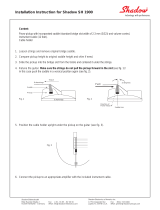
15
ENGLISH
FX_EDGE3_8_English
Maintenance
Our congratulations and deepest thanks on making Ibanez your choice of instrument.
Ibanez standards are second to none. All Ibanez instruments are set up to our strict quality
control standards before shipping. The purpose of this manual is to explain how to
maintain your instrument’s finish and to keep your guitar playing as well as it did when it
left our factory.
CLEANING
Regular cleaning of your guitar is one the most important ways
you can maintain the finish and lengthen string life. After
playing, wipe down your instrument to remove any perspiration
from the instrument. Perspiration can actually contain acids
that can be corrosive to the strings and metal parts of the
guitar. Gloss finish guitars should be polished with polish
formulated specifically for musical instruments, and a soft,
treated guitar cloth or a cotton rag. Abrasive rags such as
polyester can scratch the finish. Oil finished guitars should be
wiped clean immediately after playing with a dry cotton rag only. If your guitar has become discolored due to
extended use or heavy perspiration, factory appearance, see a qualified guitar repair person about methods to
restore the oil finish to its original factory appearance.
STRINGS AND TUNING MACHINES
If strings become dirty, discolored, or produce a dull sound or buzz, replace the
strings with new ones. For best results we recommend replacing one string at a
time, this will help to avoid removing the string tension from the neck. When
replacing strings with different gauge strings, it may be necessary to adjust the
truss rod tension. (We recommend only qualified technicians perform this.)
Instruments that have tremolo systems installed may need to be adjusted after
string replacement as changes in string tension can cause the tremolo to raise
or lower. Ibanez guitars and basses are factory equipped with the following
string gauges. Please follow the instructions below for your particular model.
The strings should be tightly wound on to the tuning machines from top to
bottom with 2 to 3 string wraps around the post. In the case of unwound guitar
strings, the ends of the strings should be prepared as shown in the diagram to
prevent unintentional slippage from the posts. In the case of tuning machines,
where the string ends are inserted into the posts, the string can be cut to length
in advance using a pair of string cutters.
If the tuning machines are sealed gear units, they are self-lubricating types. The set screws for the tuning knob
are adjustment screws that can be tightened with a small Phillips head screwdriver to increase the tension.
*The use of coarse strings may lead to buzzing and sound distortion. Using strings that have twists or kinks may cause buzzing or
decreased sustain. Make sure that the new strings are smooth and free from any defects before installing.
TIGHTEN
LOOSEN
1
2
3
STRING GAUGES
Solid guitars w/Tremolo, NDM2, JTK & ALL Gio
RG321MH, SZR, AXS, AR, ART, ARX, VBI & IC
7-String model
MMM1
MTM1
MTM2
ARTCORE guitars
Bass guitars (AFB, AGB, ARTB)
.009/.011/.016/.024/.032/.042 inch
.010/.013/.017/.026/.036/.046 inch
.010/.013/.017/.026/.036/.046/.054 inch
.014/.017/.030/.040/.056/.074 inch
.011/.014/.018/.028/.038/.049 inch
.011/.015/.018/.028/.038/.054 inch
.010/.013/.017/.030/.042/.052 inch
.050/.070/.085/.105 inch




















